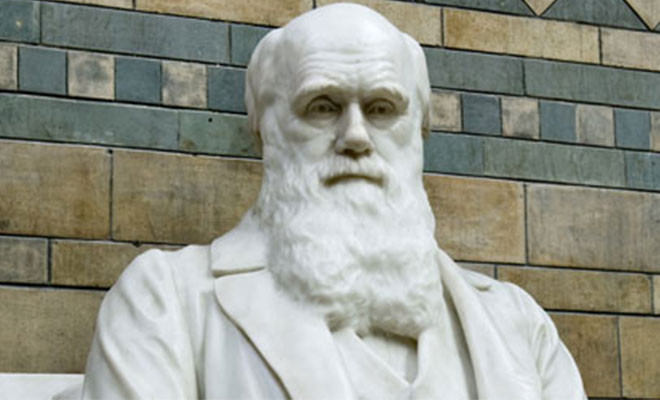
Darwin’s “Thinking Path”
NLP has long acknowledged the influence of our physiology on our thinking processes. Micro behavioral “accessing cues,” such as NLP’s celebrated eye movement patterns, are considered to be both reflections of specific mental processes and triggers for internal activity relating to the sensory representational systems. Through such physical cues we can detect as well as promote certain aspects of our cognitive strategies. This is one of the foundations of the “programming” aspect of “Neuro-Linguistic Programming.” These specific types of cues, however, are not the only kind of mind-body link. Disciplines like the Feldenkrais and Alexander methods, yoga, aikido and dance, explore a variety of other interactions between movement and mental processes. These disciplines emphasize the systemic nature of our bodies, and often focus on the pattern and quality of movement more than the specific parts of the body involved. NLP, however, has yet to take full advantage of the role of these types of ‘whole body’ movements play in human thought and ‘programming’.
I recently came across an article in Natural History magazine that provides a simple but powerful example of the relationship between general patterns of movement and the way we think. The article is essentially a reflection on the country estate of Charles Darwin (1809 – 1882), the English biologist and naturalist whose theory of evolution via the mechanism of natural selection revolutionized our understanding of natural history and shifted our perception of human origins. Darwin acquired Down House a few years after his return from his historic voyage aboard HMS Beagle. Darwin spent some 20 years after returning from his travels on the HMS Beagle working out his theories and their relationship to the evidence he had gathered and the observations he had made. It was at Down House that he wrote his classic works Origin of Species and Descent of Man.
In describing the estate, the author of the article notes
Soon after settling at Downe, Darwin constructed a sand-covered path, known as the sandwalk, that still winds through the shady woods and then returns toward the house along a sunny, hedge-lined field. He strolled it daily, referring to it as “my thinking path.” Often he would stack a few stones at the path’s entrance, and knock one away with his walking stick on completing each circuit. He could anticipate a “three-flint problem,” just as Sherlock Holmes had “three-pipe problems,” and then head home when all the stones were gone.
Reading this description, it is easy to imagine Darwin, deep in thought, strolling along his sandwalk and contemplating some key aspect of his theory of evolution and natural selection. The fact that Darwin called the sandwalk his “thinking path” indicates that he considered his walks along this path to have some significant connection with his thinking process. An intriguing question from the NLP perspective would be “What, specifically, is the link between ‘thinking’ and walking along such a path?”
Movement and Mind
The traditional NLP approach to interpreting and utilizing the relationship between thought and behavior has been to relate specific categories of body movements (such as eye movements, breathing patterns, facial expressions, gestures, etc.) to specific mental events Ð i.e., ‘eye movement up and to the left accompanies visual memory’, ‘stroking the chin indicates internal dialogue’, ‘lower, deeper breathing increases access to feelings’. NLP “accessing cues” usually focus on very subtle behaviors and address the more transient micro-structure of our thinking process.
On the other hand, repetitive physical movements and activities involving major muscle groups (such as walking, swimming, biking, playing tennis, etc.), influence our overall state of mind, and thus provide a more general context for our thinking processes.
As the allusion to Sherlock Holmes’ pipe in the quotation above indicates, the notion that deep contemplation is facilitated by some form of repetitive activity is a familiar one. In addition to his pipe, for instance, the fictional Holmes is also reported to have played a violin when needing to work out some particularly challenging aspect of a case.
Similar patterns may be found in many famous non-fictional thinkers as well. Similar to Holmes, for example, Albert Einstein played the violin during times of productive thinking, claiming that it was in some ways an extension of his thinking and that it helped him to solve particularly tricky problems. Einstein also loved to sail regularly, reportedly hastily scribbling away in his notebook whenever the wind died down. Leonardo da Vinci played the lyre. Wolfgang Amadeus Mozart, claimed that many of his best musical ideas came while he was walking or riding in a carriage. Similar to Darwin, other famous thinkers, such as Emmanuel Kant, walked as part of their daily regimen.
I myself could immediately relate to Darwin’s “thinking path” because I have had my own ‘Dreaming Path’ for many years. My home in Santa Cruz, California is near a large park, and I jog on a path through the redwood trees every morning. That path has been the birthplace and nursery of many of my seminars, software programs, books and articles.
I also swim regularly at certain times of the year, and work out on a weight machine that I have at home. I have noticed that the different qualities of movement associated with these various activities seem to bring out particular qualities of mind. The different “whole body” physical patterns seem to help access and integrate different qualities of mental processing. That is, different types of activity seem more conducive to addressing different types of outcomes and issues.
During my study of effective leadership, for example, I interviewed the founder of a large Scandinavian shipping company. He claimed that he used different physical activities to help him solve various problems. For certain issues, he would have to go out and play golf to get into the frame of mind required to deal with the issues. For other problems, he would go out and ride his bicycle in order to think about it effectively. He was so specific about which type of physiology to use that he would say, “You can’t golf on that problem. That’s one that you have to ride your bicycle on.”
It seems natural to conclude that patterns of physical activity stimulate and organize patterns of neurological activity. Riding a bicycle is an example of one way to activate and maintain a particular state. In the language of self-organization theory, we could say that certain movements create a positive ‘attractor basin’ which supports mental self organization.
There are some who might even go so far as to contend that mind is movement, and that wisdom and intelligence comes from the quality of that movement. There is an old New Guinea proverb, for instance, which states, “Knowledge is only rumor until it is in the muscle.”
‘Somatic Syntax’
These types of observations have lead Judith DeLozier and I to explore the relationship between ‘mind’ and movement more deeply in the form of what we call “Somatic Syntax.” The term “somatic” comes from the Greek word “soma” which means “body”. “Syntax” is a Greek word meaning “to put in order” or “arrange”. Thus, Somatic Syntax has to do with the organization of physiology and the ‘grammar’ of our ‘body language’. Rather than focus on physical details, Somatic Syntax emphasizes the overall pattern and organization of movement and the formation of cognitive-somatic (i.e., ‘mind-body’) strategies.
Epistemologically, Somatic Syntax is rooted in linguist Noam Chomsky’s theories of transformational grammar (1957, 1965). According to Chomsky, sensory and emotional experiences (deep structures) may be expressed through a variety of linguistic descriptions (surface structures). Deeper structures reach the surface after a series of ‘transformations’. These transformations act as a type of filter on the experiential deep structures. Grinder and Bandler (1975) maintain that the movement from deep structure to surface structure necessarily involves the processes of deletion, generalization and distortion. Many important clues about the deep structure, however, are expressed and reflected in the verbal surface structure.
Somatic Syntax applies these principles of verbal (digital) language to kinesthetic (analog) expression. As an example of the relationship between ‘deep structure’ and ‘surface structures’ in the kinesthetic system, most of us learned to write using our right or left hand. Yet, once our hand has learned this skill, it can be immediately transferred to other parts of the body. For instance, we can easily write our name in sand with our left big toe or make letters by holding a pencil in our mouth, even though the physical structure of these parts of our bodies are completely different. The deep structure related to the form of the letters is not tied to any particular part of the body. It can be generalized to many surface structures.
One of the purposes of Somatic Syntax is to deepen and widen the ‘attractor basin’ of a particular internal state or resource. Somatic Syntax employs the movement of the body as a means to strengthen, integrate and generalize deep level resources. By exploring variations in the physical form and organization of the movements associated with a particular state, for instance, we can learn to better express or manifest that state in more situations and increase our flexibility. In this way, Somatic Syntax helps to deepen our understanding and ability to utilize knowledge by bringing it more “into the muscle.”
At another level, because physical movement is related to ‘analog’ expression, it is more systemic and not ‘linear’. Consequently, exploring Somatic Syntax brings us closer to our experiential deep structures. Thus, another application of Somatic Syntax is to help recover and express parts of deep structure that may be deleted or distorted by other forms of expression. In the words of the famous dancer Isadora Duncan,” If I could say it I wouldn’t have to dance it.”
The Body as a Representational System
One of the tenets of Somatic Syntax is that the body itself is a ‘representational system’. Rather than simply being some kind of mechanical shell for inputting and outputting signals to and from the brain, Somatic Syntax views the body as a means of representing and processing information.
The typical NLP perspective has been that all our information about the world around us is relayed by the senses to the brain where it is centrally represented and processed. Recent research, such as that relating to the enteric nervous system surrounding the stomach, has demonstrated that there are sophisticated information processing networks distributed throughout the body with a structure corresponding in complexity to that of our cerebral cortex. According to Somatic Syntax, we can use our bodies to make a model of the world just as we do with our other representational systems. We can represent key relationships in the world around us and in our personal history in the relationship between parts of our body. For example, our perception of the relationship between our mother and father could be represented by the relationship between our left and right hands, or between our chest and our stomach.
In understanding the significance of Darwin’s “thinking path” it is also important to recognize that, in addition to being able to input, process and output information, all representational systems have the capability to represent information in at least two ways literally and figuratively. That is, each of our sensory systems can form maps that have either a direct correspondence or a more metaphorical correspondence to the phenomenon we are representing. For example, we can visualize the white cells of our bodies as we have seen them under the microscope, or as looking like octopi or ‘Pac-Men’ video game characters. Similarly we can speak of our brains literally as “a network of neurons”, or figuratively as being “like a computer.” Likewise, we can experience a particular emotional symptom as a particular set of kinesthetic body sensations or as a “knot” in the stomach.
As a representational system, our bodies have a similar double capacity. We can express movements which are the literal response to a particular situation, or create expressions which are more metaphorical, as in a dance. A state of anxiety, for instance, may be literally represented by reproducing the physical effects that accompany a feeling of anxiety (such as tensing up the muscle in one’s face and shoulders), or figuratively represented by placing one’s arms over one’s head and eyes, as if hiding from something dangerous. As is the case with our other representational modalities, metaphorical representations are often more meaningful and impactful (because they carry multiple levels of information).
From this perspective, Darwin’s walk along his “thinking path” can be also be viewed as a physical metaphor in addition to being a means to access and maintain a particular mental state. Walking along a path is a comparatively slow and incremental process. A path has a beginning, an end, and landmarks which indicate a direction that is leading somewhere. Looked at from the point of view of Somatic Syntax then, it is no surprise that Darwin came to perceive evolution as the result of slow, infinitesimal variations. Darwin’s theory of evolution is quite analogous to walking down a path. Clearly, Darwin ‘evolved’ his own thoughts along his sandwalk in a slow and methodical fashion, knocking away stones as he completed each successive cycle in the process Ð just like the mechanism he postulated for evolution.
In fact, according to Darwin’s own descriptions of his thinking methods, his theories themselves arose from a type of ‘natural selection’ of ideas. Like Einstein, who claimed “Imagination is more important than knowledge,” Darwin did not derive his theories from the inductive process of pondering facts and looking for patterns. Instead he creatively formed the theories first out of pure imagination, and then checked the validity of the theory with respect to the degree that they accounted for the observable facts. According to Darwin biographer Sir Gavin de Beer, “Darwin’s method was to spin a hypothesis about anything that struck his attention and then to deduce from it consequences that should follow and could be refuted or verified.” The ideas that he retained were the ones that most fit with the available data. The ideas which could not fit in met their extinction along Darwin’s thinking path. It is no wonder, then, that Darwin proposed “survival of the fittest” as the mechanism of a slow and gradual process of evolution, since it is the reflection of his own thinking process.
Of course, when we “spin a hypothesis,” it does not come out of nowhere. The source of these ideas is the activity of our nervous systems. The 17th century British philosopher and scientist Francis Bacon pointed out that, rather than take in objective information about the world around us, our nervous systems tend to project their own structure out onto the world around us. That is, the order we perceive in the world around us really says more about us than it does about objective reality. Bacon referred to our belief that our perceptions were actually mirrors of reality as the “Idol of the Tribe.”
Conclusion
Somatic Syntax is the study of how movement may be used to help bring knowledge into the muscle, and to help draw out knowledge from the muscle. It is a means to access the “wisdom of the body.” According to Somatic Syntax, repetitive structures of movement can form the framework surrounding a particular thinking process; and thus influence its conclusions. Darwin’s view of evolution follows the slow but determined act of walking down a path. In contrast, Einstein’s view of the universe, has more of the characteristics of playing a piece of music on the violin (his preferred activity while thinking) Ð each string is played relative to the other strings on the instrument in order to create the music, and the relationships determine success of the piece. Similarly, in considering Leonardo’s notebooks, one is left with the sense that his drawings are more like playing a musical instrument than methodically making repetitive circuits along a fixed path.
The most fundamental tool that we have for conducting our lives and building our futures is our own body and nervous system. Certainly the manifestation of our thoughts and dreams must eventually come through our body or physiology in some way. Our mental activity becomes manifested into the world through our words, voice tone, facial expression, body posture, the movement of our hands, etc. And the way in which we use these fundamental instruments of life is greatly influenced by the types of physical practices and disciplines we adopt.
A healthy and creative mental life is often accompanied by meditation of some type, whether it be through reading, prayer, or simply time for undisturbed contemplation. And if knowledge does indeed need to be “in the muscle” then we all also need some type of context for “muscular meditation” as well. As our world enters the next millennium, it is likely that we will all need to develop some of the wisdom and genius of people like Einstein, Darwin and da Vinci. Perhaps some of the lessons we can learn from Darwin’s “thinking path” can help us in our own evolution.







